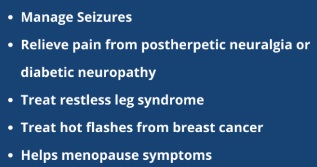Gabapentin, a medication primarily used to treat epilepsy and neuropathic pain, has garnered significant attention in both the medical community and among patients seeking relief from chronic pain and seizures. This comprehensive guide delves into the various aspects of gabapentin, exploring its uses, benefits, side effects, and the underlying mechanisms that make it an effective treatment option for many individuals.

What is Gabapentin?
Gabapentin is an anticonvulsant medication that was initially developed to treat epilepsy. It has since been found to be effective in managing neuropathic pain, which is pain caused by damage or dysfunction in the nervous system. Gabapentin works by affecting certain neurotransmitters in the brain, which helps to stabilize electrical activity and reduce pain signals.
The History of Gabapentin
Gabapentin was first synthesized in the 1970s and received approval from the U.S. Food and Drug Administration (FDA) in 1993 for the treatment of seizures. Its approval for treating neuropathic pain came later, in 2002. Since then, it has become a widely prescribed medication due to its effectiveness and relatively favorable side effect profile compared to other pain management options.
How Gabapentin Works
The exact mechanism by which gabapentin works is not entirely understood, but it is known to bind to a specific subunit of voltage-gated calcium channels in the brain. This action helps to modulate the release of excitatory neurotransmitters, thereby reducing neuronal excitability and the transmission of pain signals. By stabilizing electrical activity in the brain, gabapentin helps to control seizures and manage chronic pain conditions.

Common Gabapentin uses
Gabapentin is used for several medical conditions, the most common being epilepsy and neuropathic pain. For epilepsy, it is often prescribed as an adjunctive therapy, meaning it is used in combination with other medications to control seizures. For neuropathic pain, gabapentin is effective in conditions such as diabetic neuropathy, postherpetic neuralgia (pain following shingles), and fibromyalgia.

Gabapentin for epilepsy
In epilepsy, Gabapentin 600mg is used to treat partial seizures, which are seizures that begin in one part of the brain. It is particularly useful for patients who do not respond well to other anticonvulsant medications. Gabapentin can be prescribed for both adults and children aged three years and older, providing a broader range of treatment options for pediatric epilepsy.

Gabapentin for Neuropathic Pain
It has proven to be highly effective in treating neuropathic pain, a type of chronic pain that occurs when nerves are damaged or dysfunctional. Conditions such as diabetic neuropathy and postherpetic neuralgia can cause debilitating pain that is often resistant to conventional painkillers. Gabapentin 400mg helps to alleviate this pain by modulating pain signals and reducing neuronal excitability.

Off-Label Uses of Gabapentin
Apart from its FDA-approved uses, gabapentin Medication is also prescribed off-label for a variety of other conditions. These include anxiety disorders, bipolar disorder, insomnia, migraines, and restless legs syndrome. Off-label use refers to the prescribing of medication for conditions other than those officially approved by regulatory agencies. While gabapentin’s effectiveness in these areas varies, many patients report significant benefits.
Dosage and Administration
Gabapentin Tablets are available in various forms, including capsule tablets and oral solutions. The dosage and administration depend on the specific condition being treated, the patient’s age, weight, and kidney function. For epilepsy, the typical starting dose for adults is Gabapentin 300 mg three times a day, which can be gradually increased based on the patient’s response and tolerance. For neuropathic pain, the starting dose is usually 300 mg once a day, with gradual increases as needed.

Side Effects of Gabapentin
Like all medications, it can cause side effects. The most common ones include dizziness, drowsiness, and peripheral edema (swelling of the extremities). These side effects are generally mild and tend to diminish as the body adjusts to the medication. However, more serious side effects, such as mood changes, severe dizziness, and allergic reactions, can occur and require immediate medical attention.
Interaction with Other Medications
It can interact with other medications, which may affect its efficacy or increase the risk of side effects. Common interactions include those with antacids, which can reduce gabapentin absorption, and opioids, which can increase the risk of respiratory depression. Patients should inform their healthcare providers of all medications they are taking to avoid potential interactions.

Gabapentin and Pregnancy
The use of Gabapentin 800mg during pregnancy is a topic of concern due to the potential risks to the developing fetus. Animal studies have shown adverse effects, but there is limited data on human pregnancies. You should only use it during pregnancy if the potential benefits outweigh the risks. Pregnant women or those planning to become pregnant should discuss their treatment options with their healthcare provider.
Gabapentin in Pediatric Patients
Gabapentin is approved for use in children aged three years and older for the treatment of partial seizures. Gabapentin dosage in pediatric patients is adjusted based on weight and response to the medication. Parents and caregivers should monitor children for any side effects and report any concerns to their healthcare provider promptly.
Managing Gabapentin Withdrawal
Discontinuing Gabapentin 100mg abruptly can lead to withdrawal symptoms, particularly if the medication has been used for a prolonged period. Symptoms may include anxiety, insomnia, nausea, pain, and sweating. To minimize withdrawal symptoms, gabapentin should be tapered off gradually under the supervision of a healthcare provider.

Long-Term Use of Gabapentin
Long-term use is generally considered safe when used as prescribed. However, patients should have regular follow-ups with their healthcare provider to monitor their condition and adjust the dosage as necessary. Long-term users should also be aware of the potential for tolerance, where the medication becomes less effective over time, and the risk of dependence.
Alternatives to Gabapentin
While it is effective for many patients, it may not be suitable for everyone. Alternatives for epilepsy include other anticonvulsants such as lamotrigine, levetiracetam, and valproate. For neuropathic pain, options include medications like pregabalin, duloxetine, and amitriptyline. Patients should work with their healthcare provider to find the most appropriate treatment for their condition.
Patient Experiences and Testimonials
Many patients have shared their positive experiences with gabapentin, noting significant improvements in pain levels and quality of life. However, individual responses can vary, and some patients may experience side effects or find the medication less effective.

Gabapentin and Quality of Life
For individuals suffering from chronic pain or seizures, Gabapin 800mg can significantly improve quality of life. By reducing pain and controlling seizures, patients can engage more fully in daily activities, work, and social interactions. The medication’s benefits extend beyond symptom control, contributing to overall well-being and mental health.
Research and Future Developments
Ongoing research continues to explore new applications for gabapentin and to better understand its mechanisms of action. Studies are investigating its potential use in treating conditions such as alcohol dependence, hot flashes in menopausal women, and chronic cough. As research progresses, new insights and potential treatment options may emerge, expanding the scope of gabapentin’s use.
Read More: How Long After Taking Gabapentin Can I Drink Coffee?
FAQ:
1. What is gabapentin used for?
It is primarily used to treat epilepsy and neuropathic pain. It is also prescribed off-label for various conditions such as anxiety disorders, bipolar disorder, insomnia, migraines, and restless legs syndrome.
2. How does gabapentin work?
Gabapentin works by binding to a specific subunit of voltage-gated calcium channels in the brain, which helps modulate the release of excitatory neurotransmitters, reducing neuronal excitability and pain signals.
3. What are the common side effects of gabapentin 300mg?
Common side effects include dizziness, drowsiness, and peripheral edema. More serious side effects, such as mood changes and severe dizziness, require immediate medical attention.
4. Can gabapentin be used during pregnancy?
Gabapentin should only be used during pregnancy if the potential benefits outweigh the risks. Pregnant women or those planning to become pregnant should discuss their treatment options with their healthcare provider.
5. What should I do if I miss a dose of gabapentin 100mg?
If you miss a dose of gabapentin, take it as soon as you remember. If it is close to the time for your next dose, skip the missed dose and continue with your regular dosing schedule. Do not take a double dose to make up for a missed one.
6. How should gabapentin be stored?
Gabapentin should be stored at room temperature, away from light and moisture. Keep the medication out of reach of children and pets.
7. Can gabapentin interact with other medications?
Yes, gabapentin can interact with other medications, including antacids and opioids.

